|
Advantech PPC-3120
Intel Atom D2550-powered, versatile fanless 12.1-inch Panel PC for a variety of industrial and commercial applications where consistently reliable operation matters
review by Conrad H. Blickenstorfer -- photography by Carol Cotton
Panel PCs like the Advantech PPC-3120, introduced in 2013, are designed to bring computing to all sorts of places where a desktop or notebook computer isn't feasible or just won't do. That's places like factories, warehouses, distribution and control centers, terminals or other demanding environments that are hard on equipment, and demand superior reliability and 24/7/365 uptime to boot. Systems integrators use this type of hardware in all sort of industrial equipment, as point-of-information terminals, interactive kiosks, point-of-sale systems, commercial gaming platforms, medical projects, and numerous other applications.
Utility is where it's at with Panel PCs, and so they are usually configured as compact, sturdy boxes with display sizes ranging from very small to quite large, usually in the 6 to 19-inch range. These machines are full-function PCs although most are used to do just one thing. Application and operating environment dictate size, features and performance. With a 12.1-inch display, the Advantech PPC-3120 is a mid-size panels, and its all-in-one design makes it more of a general purpose product than some of the more specialized designs.
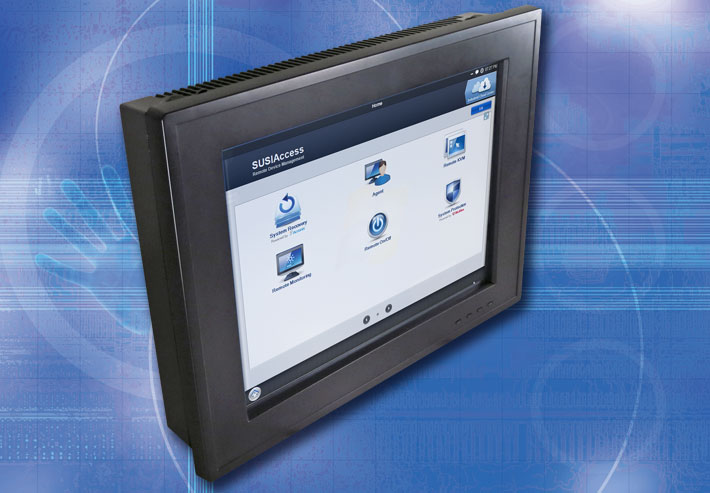
Given that today's notebooks have 17-inch displays, the 3120's 12.1-inch screen isn't very large, and, for an industrial-grade panel, the device itself is remarkably compact. Measuring 12.8 x 10 x 2.3 inches and sporting the compact, innocuous design common to almost all panel computers, the PPC-3120 weighs just over seven pounds. The display uses the conventional 4:3 aspect ratio, has an analog 5-wire resistive touchscreen, and offers wide horizontal (160 degrees) and vertical (160 degrees) viewing angles for comfortable use. Viewability under all lighting conditions is augmented by anti-glare coating and very strong 600-nit backlight (your average laptop computer has less than 200 nits).
Unlike mobile notebook and tablet computers that require a careful balance between performance, size, weight and power consumption, Panel PCs are usually A/C-powered and have fewer size and weight constraints. The emphasis here is on quiet, reliable operation and simply getting the job done. That often means tried-and-true components and a minimal number of potential points-of-failure. Cost effectiveness is an issue, too, and so companies like Advantech generally offer broad product lineups, made even broader by the availability of different colors, mounting options, software configurations, and even customization for use in tough environments.
In Advantech's Panel PC lineup, models are generally classified as either PPC-xxxT multi-functional Panel PCs or PPC-LxxxT fanless panel PCs where the first to two x's also indicate the display size. So the PPC-158T we reviewed a year ago was a multi-functional unit with a 15-inch screen, whereas the PPC-3120 in this article, also a fanless panel PC, appears to use a different nomenclature, though the 12 does refer to the screen size.
Since many Panel PCs are used as HMI (Human Machine Interface) systems, they must have sufficient onboard connectivity to interface with the machinery they are supposed to monitor and control. The PPC-3120 provides both current systems and legacy systems support with four USB 2.0 ports, three RS232 serial ports, another that supports RS232/422/485 (protocol selectable via BIOS), and also an 8-pin programmable DB9 GPIO port. There is also a VGA port for potential large/secondary screen applications, and dual Gigabit Ethernet jacks for communication with backend servers.
OS and Performance
The amount of processing power needed to make a computer fast enough depends entirely on what it is supposed to do, and to a lesser extent on what type of operating system it runs. A general purpose OS such as Microsoft Windows 7 or 8 must be able to do a vast variety of possible tasks. Therefore, they are large and need quite a bit of storage and processing power. Panel PCs usually do just fine with much less processing power because they generally perform a small number of well defined tasks, nothing more and nothing less. That, however, doesn't mean that customers and system integrators may not have very different requirements, and so the PPT-3120 can be ordered with either Windows XP Embedded or the Windows 7-based Windows Embedded Standard 7.
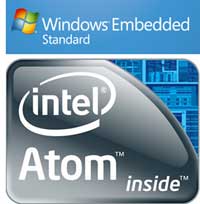 For a processor, Advantech chose a chip that is both very economical, but also powerful enough to handle any typical set of panel applications. It's the dual-core "Cedar Trail" Intel Atom D2550 which was introduced in early 2012 as an economical solution for low-end desktop computers. It has Intel Graphics Media Accelerator 3650 integrated graphics, and compared to earlier Atom designs, the chip count is down from three to two. The graphics core is running at a respectable 640MHz, compared to just 400MHz in the Atom D2500 of the same Atom generation. For a processor, Advantech chose a chip that is both very economical, but also powerful enough to handle any typical set of panel applications. It's the dual-core "Cedar Trail" Intel Atom D2550 which was introduced in early 2012 as an economical solution for low-end desktop computers. It has Intel Graphics Media Accelerator 3650 integrated graphics, and compared to earlier Atom designs, the chip count is down from three to two. The graphics core is running at a respectable 640MHz, compared to just 400MHz in the Atom D2500 of the same Atom generation.
The Atom D2550 has a TDP (thermal design power) rating of 10 watts, which is roughly halfway between the two or three watts most of the mobile Atom chips draw, and the 15-17 watts the most frugal Core processors use. Since the PPC-3120 is always plugged in (there is no internal battery), the power draw is somewhat irrelevant, except that the frugal D2550 allows a heat sink to handle the thermal load instead of a fan. As for a comparison between the Atom D525, which Advantech extensively used in panels and other systems, and the D2550, the new chip runs at a slightly faster clocksped (1.86 vs. 1.8 GHz), uses GMA 3650 instead of GMS 3150 integrated graphics, and is based on 32nm process technology instead of 45nm, which lowers the thermal design power from 13 to 10 watts.
To show where the PPC-3120 stands in terms of relative performance, we ran our standard benchmark suites on it. We're also listing the results of the Core 2 Duo powered Advantech PPC-157T we tested in 2010, the Atom D525 powered PPC-L158T and the Atom D510 based Advantech UTC-520 touch terminal, both of which we tested in 2012. Here's how the devices compare:
|
PERFORMANCE COMPARISON PASSMARK
|
PPC-3120
|
PPC-157T
|
PPC-L158T
|
UTC-515
|
|
Year tested
|
2013
|
2010
|
2012
|
2012
|
|
Intel Processor
|
Atom D2550
|
Core 2 Duo T7400
|
Atom D525
|
Atom D510
|
|
Product type
|
Panel PC
|
Panel PC
|
Panel PC
|
Panel PC
|
|
Clock speed
|
1.86GHz
|
2.16GHz
|
1.80GHz
|
1.66GHz
|
|
Thermal Design Power (TDP)
|
10 watts
|
34 watts
|
13 watts
|
13 watts
|
|
CPU Mark
|
554
|
1,292
|
552
|
512
|
|
2D Graphics Mark
|
40
|
286
|
150
|
154
|
|
Memory Mark
|
260
|
552
|
255
|
236
|
|
Disk Mark
|
548
|
460
|
497
|
261
|
|
3D Graphics Mark
|
71
|
38
|
14
|
12
|
|
Overall PassMark
|
320
|
585
|
317
|
256
|
PERFORMANCE COMPARISON
CRYSTALMARK 2004R3
|
PPC-3120
|
PPC-157T
|
PPC-158T
|
UTC-515
|
|
ALU
|
12,391
|
19,311
|
12,992
|
10,772
|
|
FPU
|
9,289
|
22,560
|
9,667
|
9,663
|
|
MEM
|
8,502
|
10,867
|
8,095
|
7,709
|
|
HDD
|
9,195
|
8,231
|
9,112
|
7,357
|
|
GDI
|
1,878
|
4,679
|
2,804
|
2,592
|
|
D2D
|
853
|
3,015
|
4,242
|
3,685
|
|
OGL
|
9,319
|
2,272
|
4,242
|
3,685
|
|
Overall CrystalMark
|
51,427
|
70,935
|
47,705
|
42,501
|
Note that benchmarks often generate weird results that do not seem to fit in. That's because they have a hard time generating directly comparable results over different processor architectures, operating systems, and storage technologies. However, overall summary results almost always provide a good idea of the relative performance of a product, and it's no different here. You can see that even an older Core 2 Duo still scores higher than any of the low-power Atoms, but it is also rated at 3.4 times the thermal design power of the D2550. The D2550 and D525 are closer than we expected, and there are larger differences between the GMA 3150 and GMA 3550 than expected as well.
What the benchmark results of the PPC-3120 mean, overall, is that the D2550 powered panel, in our configuration, is well capable of easily handling the typical panel applications load.
Enhanced Write Filter
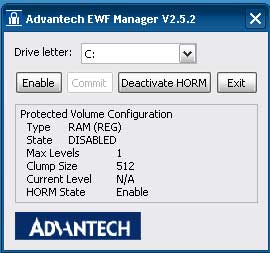 The Advantech Enhanced Write Filter Manager was installed on our test machine and I'll briefly describe it as it'll be of interest to many potential users of the PPC-3120. Enhanced Write Filter, or EWF, is an interesting security feature supported by the Windows Embedded operating systems. The Advantech Enhanced Write Filter Manager was installed on our test machine and I'll briefly describe it as it'll be of interest to many potential users of the PPC-3120. Enhanced Write Filter, or EWF, is an interesting security feature supported by the Windows Embedded operating systems.
What the Enhanced Write Filter does is provide the ability to write-protect a run-time image. It does that by redirecting write operations to another storage location and totally write-protects the run-time image, thus preventing any damage that might be caused by an unexpected power failure, vibration or even a virus attack.
Taking full advantage of EWF technology requires some studying and proper configuration of a system. To learn more about this particular feature of Windows Embedded, read the EFW Manager and EWF Components sections at the Microsoft Embedded Developer Center.
Straightforward design
Panel PCs are, for the most part, designed to be reliable, utilitarian tools for industrial jobs. The emphasis is on simplicity and functionality rather than eye-catching design. The picture below shows the PPC-3120 from the front and all four sides. The black front bezel and housing are tough black plastic, the chassis inside is all steel. There are cooling slots and a few other openings indicating that that this is, with the exception of the IP65-protected front bezel, not a sealed system. Note that the front bezel snaps on and can easily be replaced.
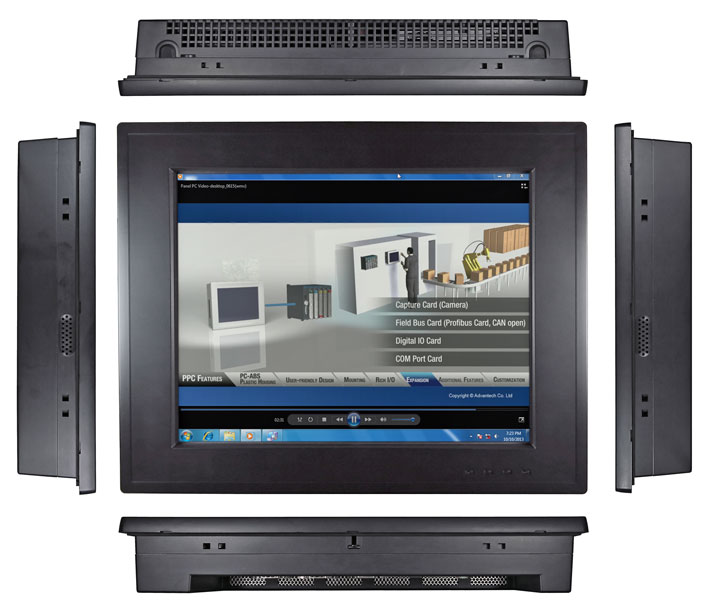
Looking at the four sides, you can see that all wired connectivity is concentrated along the bottom side, facing backward.
At this point we normally show pictures of what it looks like inside the unit, so that we can explain components and their arrangement as well as give potential customers an idea of what to expect in terms of expandability, access and service. In this case, Advantech asked us not to open the unit. So all we can say is that the interior is dominated by the large finned heat sink that eliminates the need for a fan. Next to it is the 250GB 2.5-inch Seagate Momentus Thin hard disk, nicely shock-mounted in rubber bushings. Visibly also is a mini PCIe connector that can be used for an optional WiFi card or, if need be, a field bus or digital I/O card, or even a card for an external image capture camera.
Below is a close-up of the rear-facing I/O panel of the PCM-3120:

Ruggedness
As a panel PC, the Advantech PPC-3120 has different ruggedness requirements than a mobile computer. It's not likely to get dropped since it will be installed in a panel or other stationary setting. And since it is most likely used indoors, it won't get rained on. However, it is expected to run reliably 24/7 in factory settings where temperature, vibration, and exposure to water still can be issues.
As a result, the PPC-3120 is sturdy and very well built. The industrial plastic bezel and housing won't easily scratch or break. When mounted in a panel, a neoprene gasket behind the bezel lip effectively seals the computer. So while the housing itself has ventilation slots and standard connectors, from the front the system carries the equivalent of IP65 sealing. This means that a panel with the PPC-3120 installed could be hosed down and not incur any damage.
In terms of operating temperature, panels are not generally installed freezers, and so the device is designed to operate within a range of 32 to 122 degrees Fahrenheit, well beyond the range where human operators can comfortably work.
Advantech does provide shock test figures and certifies the panel to 10G peak acceleration for a duration of 11 msec.
Bottom line: Advantech PPC-3120 fanless Panel PC
The Advantech PPC-3120 is a versatile industrial panel computer from an experienced Taiwanese embedded and industrial systems manufacturer with a worldwide presence. Its power-efficient dual-core 1.86GHz Intel Atom D2550 processor generates so little heat that the unit does not require a fan.
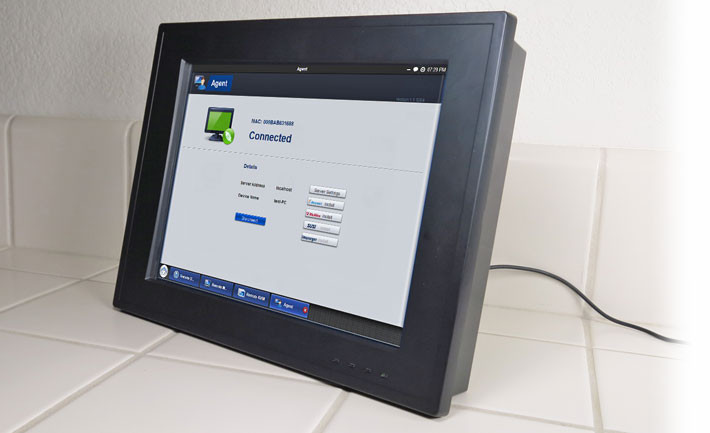
The PPC-3120 is generally configured as an embedded device running either the Windows XP Embedded or Windows Embedded Standard 7 operating systems from an internal SATA hard disk. The unit comes with up to a 4GB of DDR3 RAM in a single SODIMM slot. The Atom D2550 processor provides adequate performance for applications this type of Panel PC is intended for. When mounted in a panel, the PPC-3120's front bezel is sealed to IP65 specifications. The unit is designed to handle the abuse (shock, temperature, humidity, etc.) likely encountered in an industrial environment.
Advantech offers panel computers with a wide variety of screen sizes and touchscreen technologies. The PPC-3120 with its 12.1-inch XGA touch display with 4:3 aspect ratio is designed to fit into tight spaces. The display has excellent anti-glare properties and is quite immune to smudges and fingerprint. The analog resistive 5-wire touch screen that was very responsive and highly configurable for optimal use with both a stylus or fingers.
The PPC-3120 offers excellent onboard connectivity for use with a variety of current or legacy devices and peripherals. You get four external USB 2.0 USB ports, four RS232 and RS232/422/485/TTL serial ports, video for an external monitor, and dual LAN. There is an internal mini-PCIe slot and an an additional optional PCI/PCIe via riser.
The PPC-3120 is a cleanly designed, no-nonsense panel computer that combines versatility, ruggedness, easy customization and maintenance, and enough performance. It can be configured for a large variety of applications in all kinds of manufacturing and industrial settings, with application in numerous other settings as well.
-- Conrad H. Blickenstorfer, October 2013
Advantech PPC-3120 specs:
| Status |
Added 10/2013
|
| Type |
Fanless Panel PC
|
| CPU Type |
Dual-core Intel Atom D2550
|
| Chipset |
Intel NM10
|
| BIOS |
AMIBIOS 16Mbit SPI flash
|
| OS |
Windows Embedded Standard 7, Windows XP Embedded
|
| API support |
iManager, SUSIAccess and Embedded Software APIs
|
| Memory |
Max48GB DDR3 1066MHz via 1 204-pin SODIMM slot
|
| Graphics Controller |
Intel integrated
|
| VRAM |
Unknown
|
| Video-out |
1 x VGA
|
| Dual display |
No
|
| LAN |
2 x RJ45 10/100/1000
|
| SATA |
Yes, 1 x SATA/300 |
| IDE/EIDE |
NA
|
| SSD |
via mSATA
|
| Expansion: PCI |
1 x MiniPCIe, 1 x PCI/PCI-e through optional riser
|
| USB |
4 x USB 2.0 |
| Serial |
3 x RS232, 1 x RS232/422/485
|
| Audio |
1 x line-out, 1 x mic
|
| GPIO |
1 x DB9 GPIO (8 pin programmable)
|
| Watchdog Timer |
Yes, 1 (System reset, programmable 1 ~ 255 sec/min) |
| Size |
12.8 x 10 x 2.3 inches (325 x 254 x 58 mm)
|
| Weight |
7.3 lbs (3.3 kg)
|
| Operating Temp. |
With HD: 32° to 122°F |
| Sealing |
IP65 front panel protection
|
| Shock |
Operating 10 G peak acceleration (11 ms duration), per IEC 60068-2-27
|
| EMC |
BSMI, CE, FCC Class B
|
| Safety |
CB, CCC, BSMI, UL
|
| Vibration |
Operating Random Vibration Test 5~500Hz, 1Grms, per IEC 60068-2-64
|
| Price |
Starting at US$1,143
|
| Web page |
 PPC-3120 page PPC-3120 page |
| Datasheet |
 PPC-3120 spec sheet PPC-3120 spec sheet |
Advantech Corporation
13 Whatney
Irvine, CA 92618
Toll Free: 1-800-866-6008
Ph: 949-420-2500
Fax: 949-420-2501
ECGInfo@advantech.com
www.advantech.com
Advantech Co. Ltd.
No.1, Alley 20, Lane 26, Rueiguang Road
Neihu District, Taipei Taiwan 114, R.O.C.
Tel: 886-2-2792-7818
Fax: 886-2-2794-7301
www.advantech.com
|



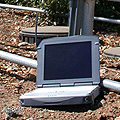

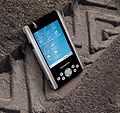
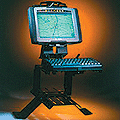






 For a processor, Advantech chose a chip that is both very economical, but also powerful enough to handle any typical set of panel applications. It's the dual-core "Cedar Trail" Intel Atom D2550 which was introduced in early 2012 as an economical solution for low-end desktop computers. It has Intel Graphics Media Accelerator 3650 integrated graphics, and compared to earlier Atom designs, the chip count is down from three to two. The graphics core is running at a respectable 640MHz, compared to just 400MHz in the Atom D2500 of the same Atom generation.
For a processor, Advantech chose a chip that is both very economical, but also powerful enough to handle any typical set of panel applications. It's the dual-core "Cedar Trail" Intel Atom D2550 which was introduced in early 2012 as an economical solution for low-end desktop computers. It has Intel Graphics Media Accelerator 3650 integrated graphics, and compared to earlier Atom designs, the chip count is down from three to two. The graphics core is running at a respectable 640MHz, compared to just 400MHz in the Atom D2500 of the same Atom generation.
 The Advantech Enhanced Write Filter Manager was installed on our test machine and I'll briefly describe it as it'll be of interest to many potential users of the PPC-3120. Enhanced Write Filter, or EWF, is an interesting security feature supported by the Windows Embedded operating systems.
The Advantech Enhanced Write Filter Manager was installed on our test machine and I'll briefly describe it as it'll be of interest to many potential users of the PPC-3120. Enhanced Write Filter, or EWF, is an interesting security feature supported by the Windows Embedded operating systems.



